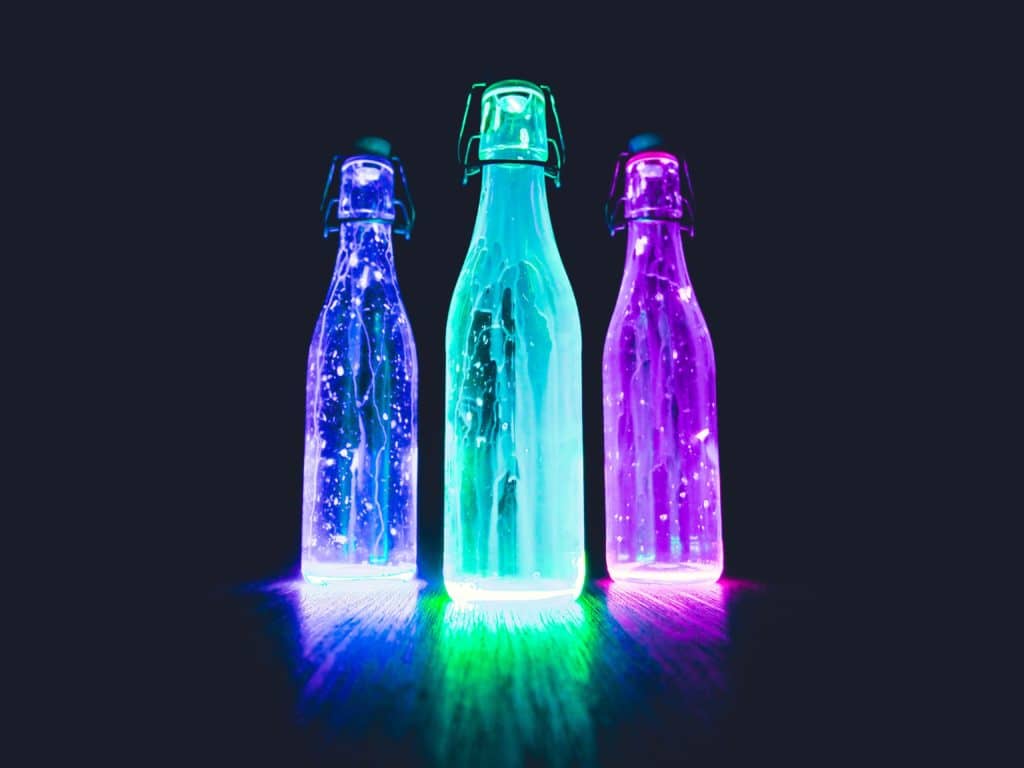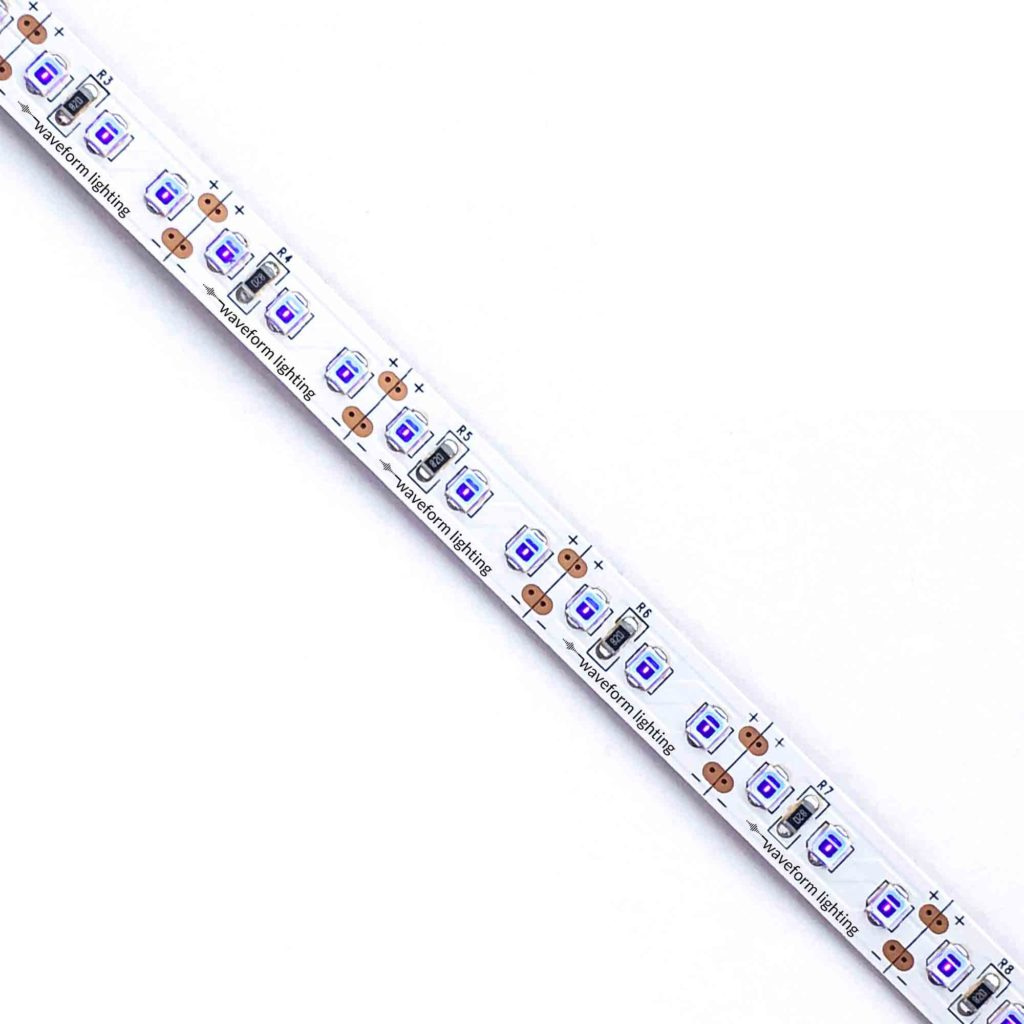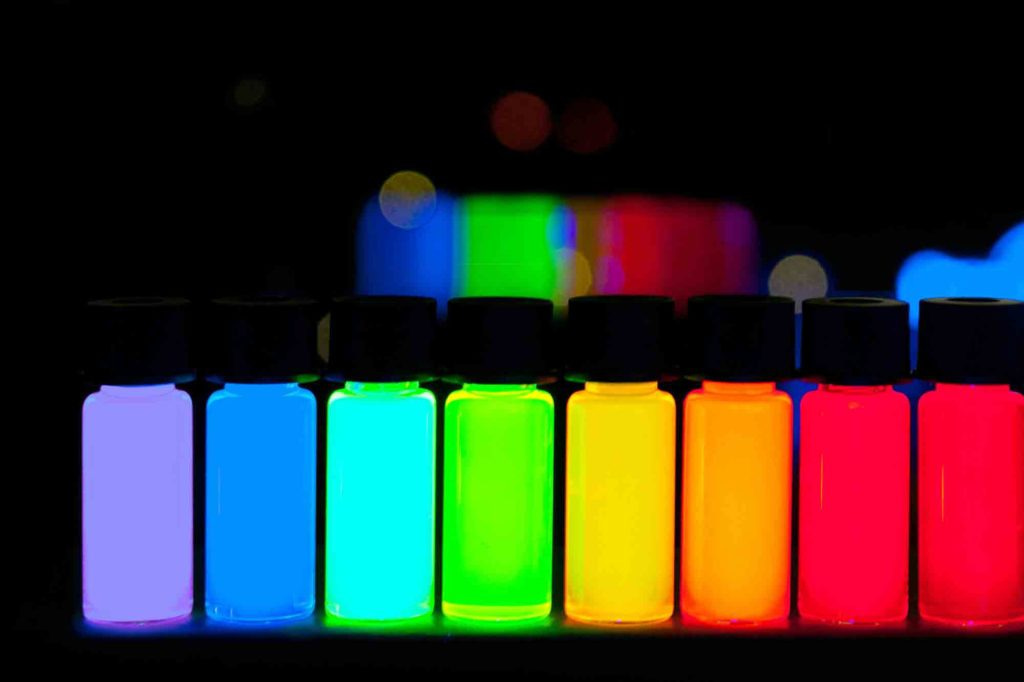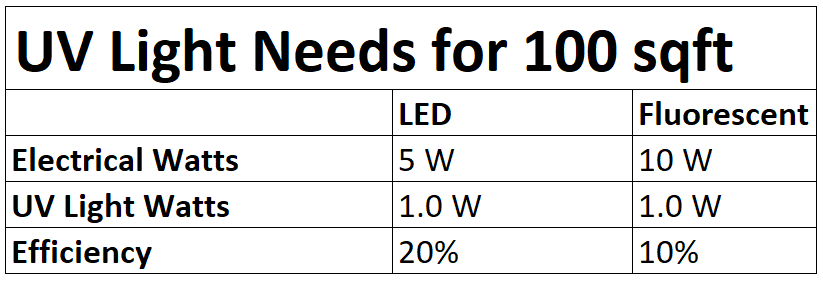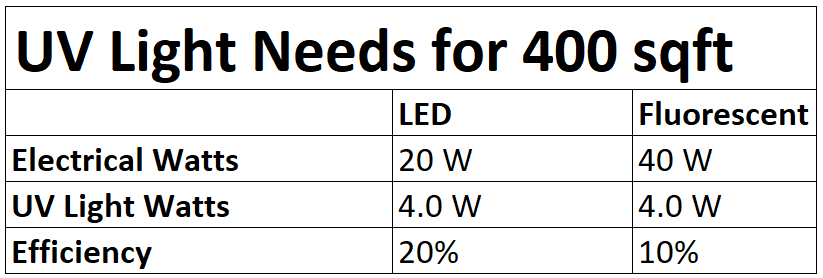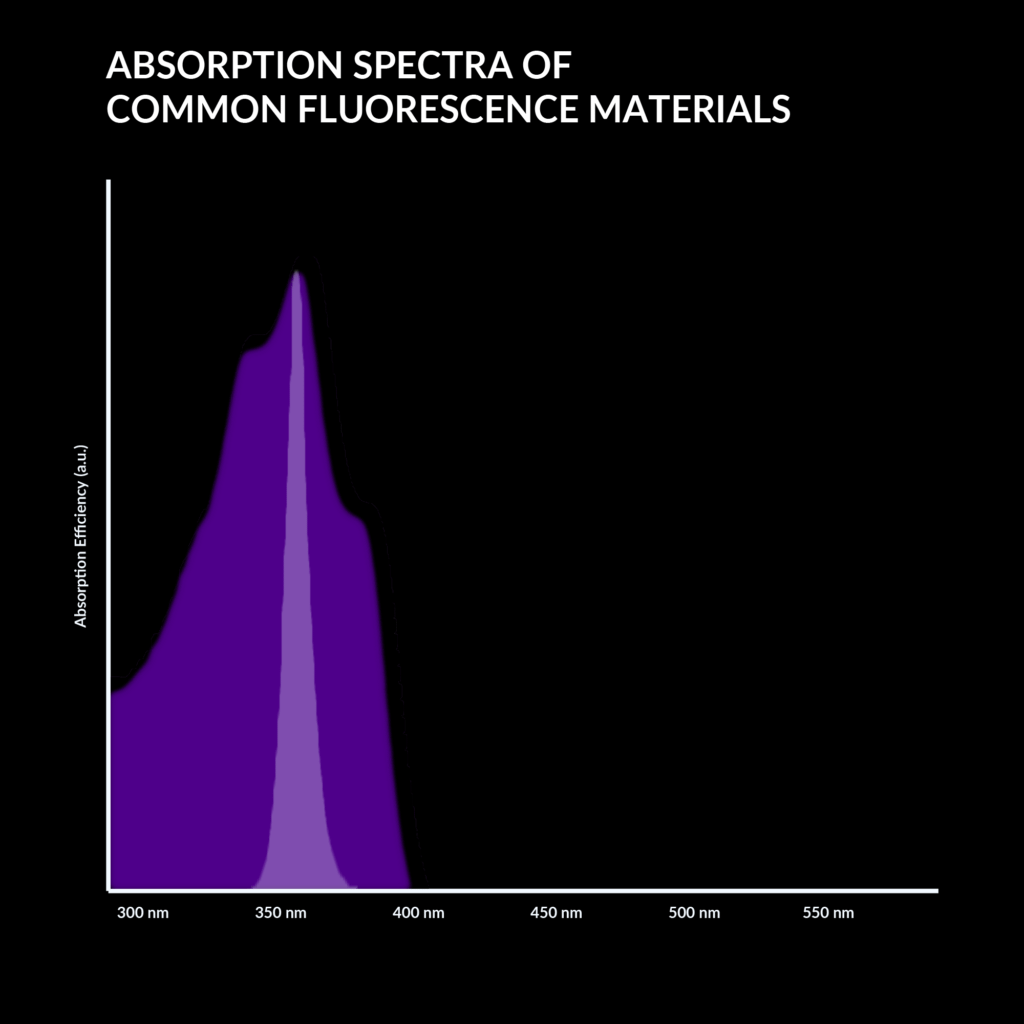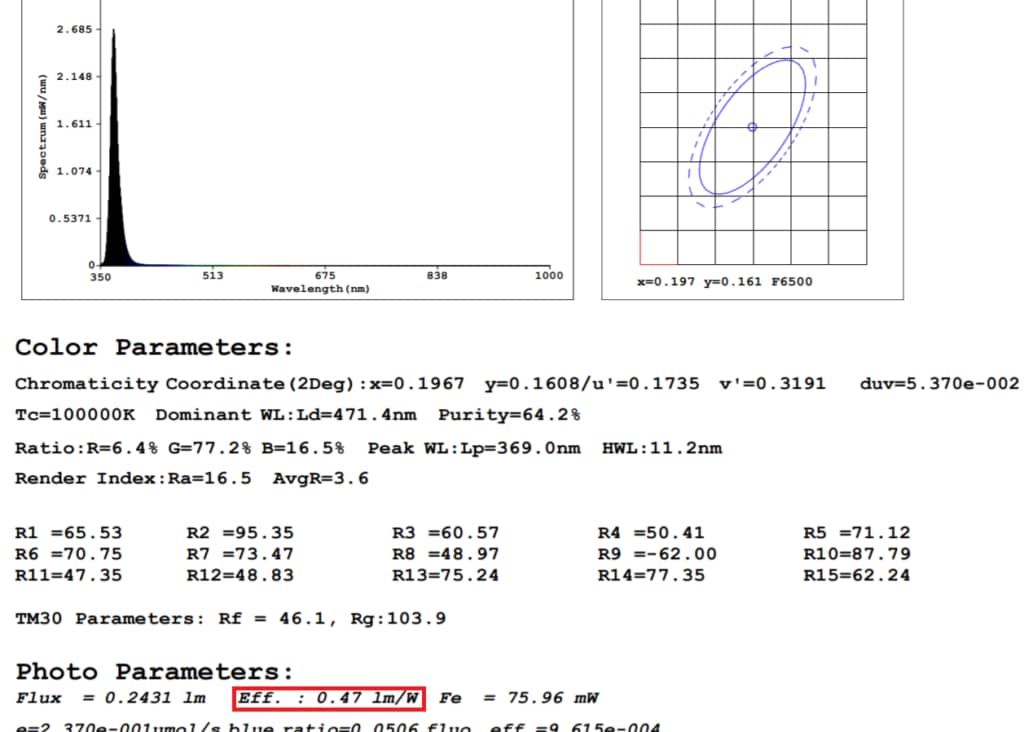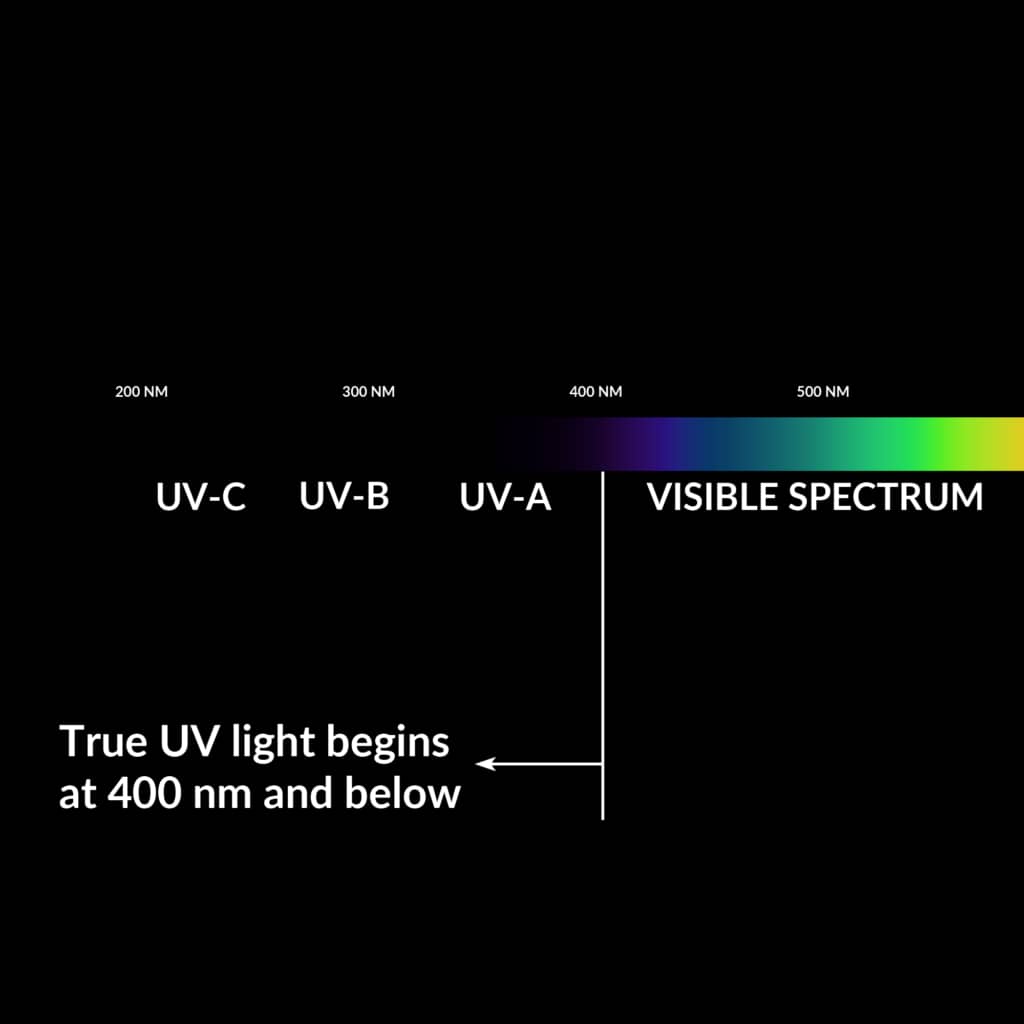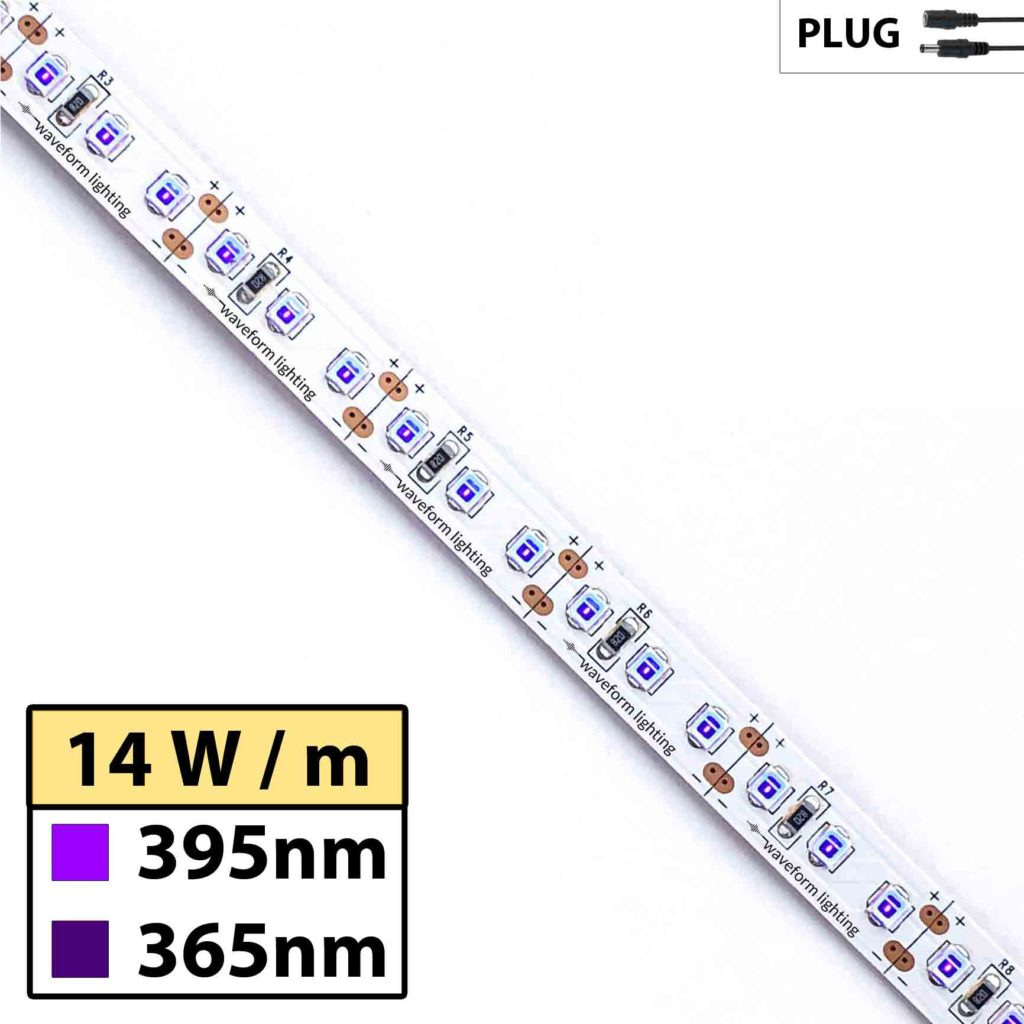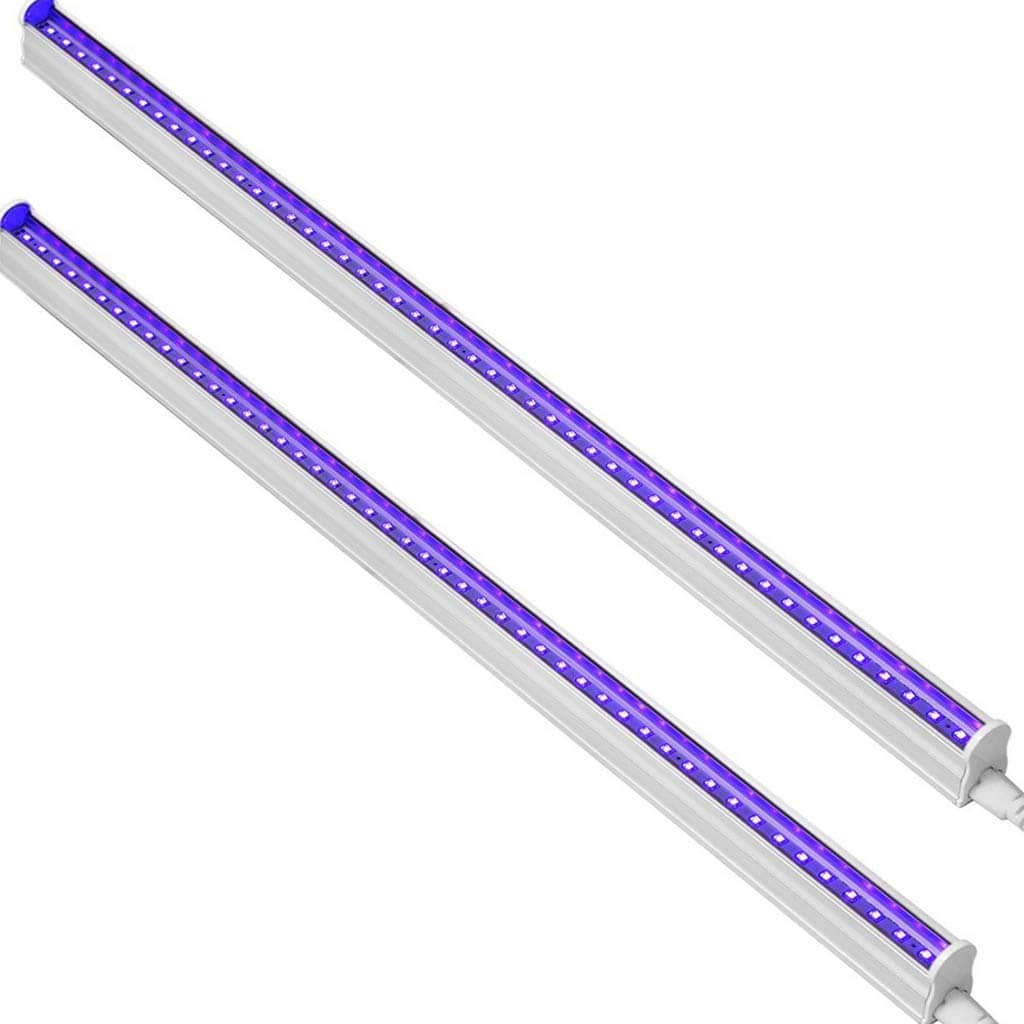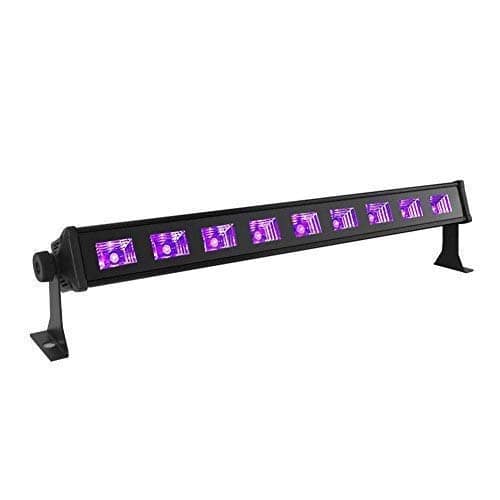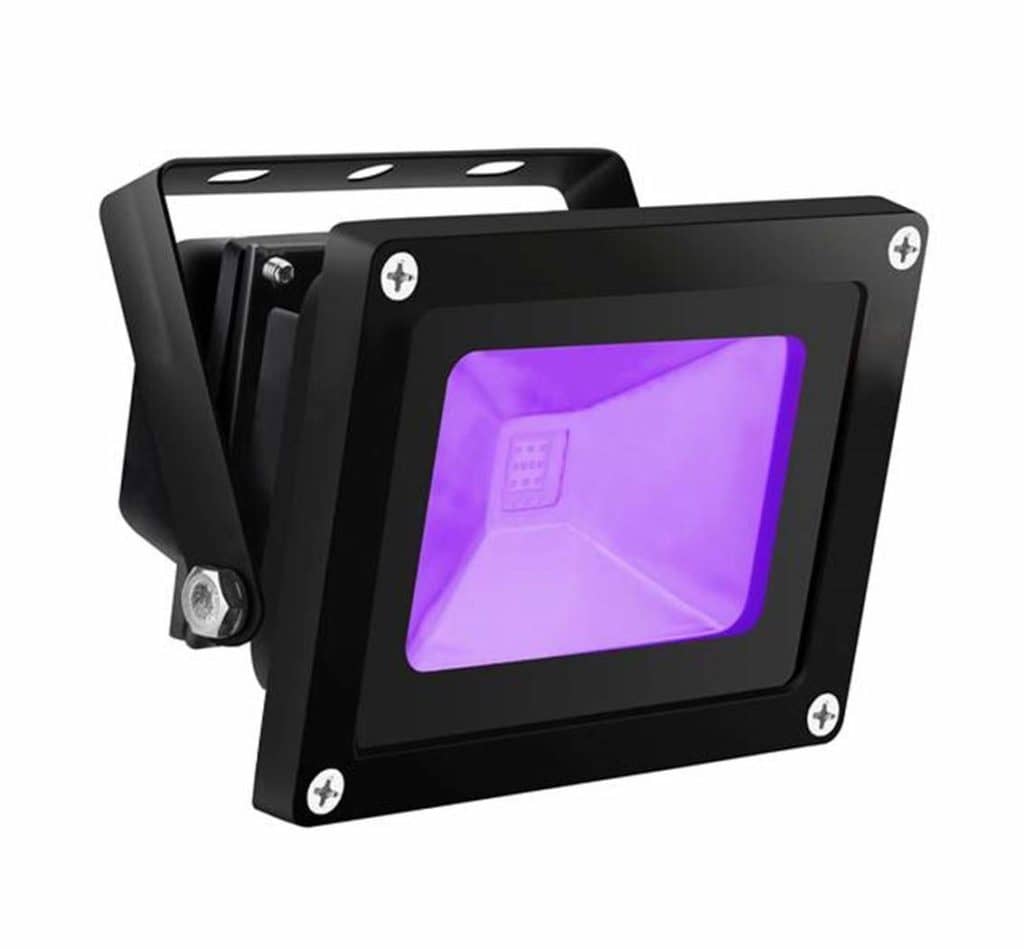https://www.waveformlighting.com/tech/top-4-things-to-consider-before-buying-uv-blacklights
UV blacklights are great devices with a wide range of applications in the arts, industry, and scientific research. Unlike regular white light bulbs, UV blacklights are unique in that they primarily emit ultraviolet radiation as opposed to visible light, and as a result, there are some additional factors you will want to consider before making a purchase.
Blacklights are most commonly used when the fluorescence of objects needs to be observed, with as little visible light as possible. Generally, this means that a blacklight will emit primarily UV-A radiation, and very little visible light. Below, we discuss 4 questions you should consider before purchasing a UV blacklight.
WARNING: Always use common sense and observe safety around the use of UV lights. The amount and intensity of UV-A light energy emitted by blacklights is generally below dangerous levels, but be aware that the UV light energy emitted by the lamps is invisible. Do not, for example, look directly into a UV LED blacklight when it is turned on, even if it does not appear bright. It may not appear like much, but the dim light you see is just a small fraction of the actual UV light energy hitting your eyes.
1) Which Ultraviolet Blacklight Lighting Technology is Best?
For most applications and installations, UV blacklights are available either as a fluorescent lamp or an LED light. Until recently, fluorescent lamp blacklights were the primary option, but with rapid advances in LED technology, UV LED lights are quickly becoming the preferred option.
Some advantages of UV LED blacklights include:
- Higher efficiency – UV LED lights are typically 1.5x – 3.0x more efficient than fluorescent UV blacklights
- Longer lifetimes – UV LED lights last for 25,000 hours or more, and do not "burn out" like a fluorescent lamp – their UV light output gradually diminishes over time. Fluorescent blacklights typically last only 5000 hours and fail catastrophically.
- No mercury or hazardous materials – UV LEDs do not have any mercury or other hazardous materials that are commonly present in fluorescent lamps. As a result, you won't need to worry about accidentally breaking a UV LED lamp and have to do any special handling of the cleanup.
Fluorescent blacklights can oftentimes be cheaper than an LED blacklight, so if you're on a tight budget, fluorescent UV blacklights might be the way to go, especially for short-term use. Don't forget to consider, however, the lifetime and efficiencies in any cost of ownership calculations.
2) How Much UV Do I Need?
UV blacklight "brightness" is a difficult metric to describe, because UV light energy is not directly visible. Although lumens is typically the metric used to measure the amount of visible light, because ultraviolet light is invisible, this metric is essentially useless. For UV lights, the most accurate metric is "watts" of UV light output.
What is a "watt" of UV light? Watts are simply units of energy, and as you may recall from your introductory physics classes, energy can exist in a variety of forms – for example, electrical, kinetic, chemical, or light energy. In this case, we are measuring the amount of light energy emitted in the UV wavelengths.
For most basic applications, 1 watt of UV light energy output is sufficient to create strong fluorescence effects over a 100 sq ft area. For a 200 sq ft area, simply multiply the target UV levels by 2x for an estimated 2 watts of UV light energy needed.
IMPORTANT: electrical watts does not equal UV light watts! As with regular household light bulbs (e.g. 60 Watts), we are most accustomed to describing UV light bulb power in terms of its electrical energy consumption. But as is the case with household light bulbs, what matters most is the amount of light energy produced.
Unfortunately, most manufacturers do not list the UV light output, and instead simply indicate the electrical watts input. For example, you may find a product described as a 40 Watt UV blacklight, but unfortunately all this means is that the lamp consumes 40 watts of electrical energy – this does not provide us with any information about its efficiency, and how much actual UV light energy is produced. It could be a great, efficient light emitting 10 watts of UV (25% efficiency), or a terrible light with 1 watt of UV (2.5%) – we just don't know from the 40 watts power consumption alone.
If a product lists the amount of UV light output in watts, you can use this value directly to estimate your UV light needs for a space. If not, you may have to use some rough efficiency estimates.
As a rough ballpark estimate, fluorescent blacklights have an efficiency value of 5-15%. In other words, for every 100 Watts of electrical energy consumed, the blacklight will emit 5-15W of useful UV light energy.
UV LED blacklights, on the other hand, have improved efficiency values of 15-25%. For the same 100 Watts of electrical energy consumed, UV LEDs will emit 15-25W of useful UV light energy.
Because efficiency values can vary significantly depending on the quality and design of UV blacklights, try to stick with products for which you can find the actual UV light output values indicated on a product's specifications sheet. If you do want to proceed without this data, you may want to use 20% as a rough estimate for UV LED efficiency, and 10% for fluorescent blacklight efficiency.
Below is a quick lookup table based on efficiency estimates of 20% and 10% for UV LEDs and fluorescent blacklights. Keep in mind that these efficiency estimates are ballpark estimates only, and individual products can vary in their actual efficiency values.
Below are two examples for determining how much UV light you need:
Example 1: How many feet of realUV 395 nm LED Strips for a 200 sqft area?
We first note that the UV output for the product is 0.9 watts per foot. Based on our estimated UV light needs of 1 W per 100 sqft, we determine that we will need 2 W for our 200 sqft area (multiply by 2x).
Dividing 2 watts by 0.9 watts per foot gives us 2.2 ft.
Therefore, our estimated realUV LED strip length needs is approximately 2.2 ft.
Example 2: How many 20W UV Fluorescent Blacklight bulbs are needed for a 400 sqft room?
For this example, we assume we do not know the efficiency value of the fluorescent UV bulbs.So, based on our rough estimate of 10%, we will estimate 2 watts of UV light output per blacklight bulb.
Our recommendation for a 100 sqft area is 1W, so you will likely want anywhere between 2-3 of these fluorescent UV blacklight bulbs that each emit 2 watts of UV, to get the UV lighting effect you are looking for in a 400 sqft area.
3) Which Wavelengths of UV Do I Need?
Ultraviolet light encompasses a wide range of wavelengths, but most blacklight applications utilize a narrow range of ultraviolet radiation (UV-A) to produce fluorescence effects – specifically between 350 and 400 nm (nanometers).
But even within the 350-400 nm range, different wavelengths can create stronger or weaker fluorescence effects. As the chart below shows, most fluorescence is strongest in the 320-380 nm range, with a peak at 365 nm.
Therefore, we would typically recommend a wavelength of 365 nm for most blacklight applications where maximum fluorescence is desired.
However, there are some reasons you may want to choose another wavelength. For UV LEDs, the general rule is that the shorter the wavelength, the higher the price. 395 nm UV LEDs, for example, are a common and relatively affordable option that provides decent levels of fluorescence at a more affordable price point.
The downside to these longer wavelengths is that you will likely observe lower fluorescent effects, and you may also see some more visible "dark purple" light. A common phenomenon observed is a purple shadow cast by objects – a true 365 nm blacklight would be invisible, and therefore not cast any shadows.
Typically, light above 400 nm is considered violet light – i.e. visible light that has a deep purple color, so 395 nm is the longest wavelength option you should consider for a blacklight application.
A quick way to determine how much (undesirable) visible light is being emitted by the blacklight is to find its luminous efficacy, which is expressed in lumens per watt. All else equal, a UV black light with a luminous efficacy of less than 0.5 lumens per watt is best. You can typically find luminous efficacy values listed in the photometric test reports of blacklight products.
What does 0.5 lumens per watt signify? Lumens is a measure of brightness, used to measure light output in standard white lights. A 40 watt incandescent bulb emits 450 lumens. Therefore, 0.5 lumens per watt means that half a lumen will be emitted for every 1 watt of electrical energy consumed.
As a concrete example: a 10 watt UV blacklight emitting 0.5 lumens per watt will emit 5 lumens of visible light – approximately 1% of the brightness of a 40 watt incandescent bulb.
Be aware that many products will not explicitly list the wavelength of UV used, or if is, it is commonly hidden in small text, where you will find out that it may be 400 or even 405 nm. These wavelengths are easier and lower cost to manufacture, and result in weaker or even nonexistent fluorescence effects than 395 nm blacklights.
4) What Type of UV Light Fixtures Should I Use?
Finally, when choosing a UV light fixture, you should know that they can come in a variety of shapes and forms. Below, we've listed several examples and situations where they could be useful.
UV LED Strip Light
One of the most versatile form factors is a UV LED flexible strip. The LED strip consists of many ultraviolet LEDs (365 or 395 nm) mounted on a flexible circuitboard approximately half an inch in width.
The LED strips can be cut to length in 1-inch intervals, meaning you can install these in tight spaces such as photoboxes and display cabinets. Best of all, because they operate on very low voltage 12V DC, there is virtually no electrical or fire risk.
The backside of the LED flexible strip includes a double-sided adhesive material that can be used to apply to LED strip to virtually any surface.
Because the LED strip is flexible, it can even be installed on curved or uneven places.
Purchase Waveform Lighting's realUV LED strips here.
Rigid UV LED Light Bar
Rigid UV LED light bars are similar to the LED strips, but are better suited for more permanent installations, or those requiring more robustness. They are typically available in 1, 2, or 4 ft lengths, and can be daisy chained for simplified installation.
Rigid UV LED light bars are well suited for installation on trusses, shelves, or cabinets, where the light can be installed on a straight and flat surface.
UV LED Wall Washers
Wall washer UV blacklights are designed to cover a wall surface with UV light, either to illuminate objects with fluroescence on the wall (e.g. fluorescent wall art), or to allow the UV light to "bounce off" of the wall and reflect into the entire room.
Most wall washers come in 2 to 4 ft lengths, and are designed to be mounted into the floor. The lamp itself can be adjusted so that the UV light energy can be directed at the specific angles required.
Wall washers are great for semi-permanent installations such as bars, nightclubs and event spaces where covering large, vertical surfaces is needed. Alternatively, they can be used to reflect the UV light from the wall and into the rest of the space. One of the big advantages of this approach is that it allows the UV light to disperse, creating a very even distribution of light energy. Keep in mind that you may lose some UV light energy in this process, so you may need a little extra UV light in your wattage calculations above.
UV LED Flood Lights
As its name suggests, UV flood lights are great when needing to "flood" a large area with UV light. Similar to wall-washers, these fixtures typically include the ability to adjust the angle of the UV light.
Most UV flood lights are also designed for outdoor use, so for any outdoor applications requiring fluorescence, these lights are a great option. Got outdoor events and parties with fluorescent objects? Or looking to incorporate some fluorescent architectural or landscaping features? The outdoor UV LED flood will be sure to be a great fit.
When installing these flood lights, be sure to install multiple lights from multiple angles, as this will help prevent "UV shadows" where some areas don't receive enough UV light energy to produce fluorescence due to objects blocking the UV light.
https://uvhero.com/difference-uv-light-black-light/
The Difference Between UV Light and Black Light
When reading about uv light, there are these two terms that seem to be confusing: UV light and black light.
In a nutshell, there isn’t quite a difference, but a misunderstanding of the terms. Black light is nothing but UVA light, while UV light is basically composed out of UVA, UVB and UVC. So in other words, black light is UV light(450-100nm), covering the 400-320nm spectrum.
To better understand the difference, it’s essential to know what each of the terms means. Today, am going to help you with that, starting with the very basic definitions.
Definition of ultraviolet light
Ultraviolet light is an electromagnetic radiation or light that is in between the visible spectrum and x-beams. Ultraviolet light is light with the wavelength in the range of 10 nm to 400 nm with energies from 3eV to 124 eV. Ultraviolet light gets its name since it is the light nearest to the violet part of visible light.
Ultraviolet light is a section of the electromagnetic spectrum that reaches the earth from the sun. It has wavelengths shorter than normal visible light, making it invisible to the naked eye.
Spectrum
The colors we see are controlled by the wavelength of light vitality. Unlike some insects, people can just view the spectrum from red to violet. In any case, other invisible “colors” exist above and underneath this spectrum. The “color” of above red is called infrared, and the color underneath violet is called ultraviolet. Ultraviolet light will make fluorescent or luminous pigments fluoresce, emanating visible light.
The ultraviolet spectrum is separated into subcategories depending on the wavelength:
- 450 – 400 nm Violet, (visible light)
- 400 – 320 nm UVA, Long Wave, Black Light
- 320 – 280 nm UVB, Medium Wave
- 280 – 100 nm Short Wave, Germicidal
Types of UV Bands
Ultraviolet radiation can be broken down into three distinct bands: UVA, UVB, and UVC.
With considerably shorter rays, most UVC is absorbed by the ozone layer and does not reach the earth. Both UVA and UVB, be that as it may, infiltrate the atmosphere and leads to skin problems, for example, premature skin aging. By harming the skins cell DNA, extreme UV radiation produces genetic changes that can cause skin disease.
UVA Rays:
UVA has the longest wavelength compared with three bands. Its wavelength ranges between 320–400 nanometers. UVA rays represent up to 95% of the UV radiation reaching the Earth’s surface. They go through the ozone layer and reach the earth. They are available with moderately measure up to force during all daylight hours consistently. UVA rays are powerful to the point that they also enter some garments, mists and even glass. Likewise, UVA rays contribute to skin maturing and wrinkling because they can infiltrate deep into the skin, harming the cells underneath.
UVA is the powerful tanning beam. Tan results from damage to the skin’s DNA; the skin darkens in an endeavor to avoid further DNA harm. UVA may serve to cause the most dangerous type of skin cancer. These incorporate melanoma. As indicated by late research, first exposure to tanning beds before the age of 30 builds danger of skin malignancy by 75%.Recently, thinks about have distinguished that this type of radiation influences the body’s immune system and goes about as an immunosuppressive agent. Research has also demonstrated that exposure to UVA causes a substantial fall in the bodies in susceptible cells which like this make it simpler for threatening cells to develop.
UVB Rays:
UVB wavelength is 290-320 nm. UVB rays intensity varies depending on the season, area, and time of day. They are most prevalent in northern half of the globe summer months or when parts of the earth orbit nearest to the sun. UVB rays, the prime reason for skin blushing and sunburn tends to harm the skin’s more superficial epidermal layers. They can likewise prompt the advancement of skin malignancies. It assumes a contributory part in tanning and photo aging.
Not at all like UVA rays, these rays aren’t a similar quality year round – They’re more common in the late spring months, in any case, they can reflect off of water or snow, so it’s constantly imperative to secure yourself year-round. UVB rays are in charge of bringing on most skin malignancies. While extensive measurements of UVA rays can add to a tumor, it’s the UVB rays that are generally to the fault.
UVC Rays:
UVC rays have the wavelength of 200-290 nm. These rays have the shortest wavelength. They are the most hazardous among all the rays. Be that as it may, these rays don’t reach the earth’s surface as the ozone layer totally absorbs them.
Definition of Black Light
A “black light” is a specific type of ultraviolet light. It emanates ultraviolet radiation for the most part in the long-wave UV-A region. The glass has a filter which stops the majority of the visible light and short-wave UV. In spite of the fact that UV-A is safe, it can result in any case damage your eyes if they’re exposed to it for a long time.
Therefore, a black light is part of the UV light. Black lights emit ultraviolet radiation (UV light) in the UV-A band.
UVA rays are the longest-wavelength, most lowest-energy type of UV radiation and the type that is less harmful. It’s the UVB, and UVC rays in sunlight that leads to the most damage continued exposure to which can cause sunburn and skin cancer.
Black Lights
The term black light refers to a specific type of light – normally fluorescent – with a unique luminous covering that produces UV radiation in the UVA range.
Phosphorescence is a process by which materials emit put stored energy gradually, like visible light. It is commonly used as a part of “glow-in-the-dark” materials, which absorb energy through exposure to light and after that emanate it gradually in darkness, giving off a soft gleam.
How Black Light Functions
You have likely seen black lights at entertainment parks, science museums, and Halloween shows. Black lights may look simply like typical fluorescent lights or radiant light bulbs. However, they do something totally different. Switch one on, and white garments, teeth, and different things shine oblivious.
The regular black light outline is only a fluorescent light with two or three critical modifications. Fluorescent lights generate light by passing electricity through a tube loaded with inert gas and a small amount of mercury.
When invigorated or energized, mercury molecules radiate energy as light photons. They radiate some visible light photons, however, for the most part; they transmit photons in the ultraviolet (UV) wavelength range. Since UV light waves are invisible to the human eye, fluorescent lights need to change this energy into visible light. They do this with a phosphor covering around the outside of the tube.
Black Light vs Black Light Blue
Terms for black light bulbs are somewhat different than for the apparatuses. Black light installations contain a knob called a “Black Light Blue” or BLB bulb. This bulb utilizes cobalt blue glass and emanates little purple visible light in addition to the long wave ultraviolet light.
There are additionally “Black Light” or BL bulbs. These bulbs are made of a reflective glass and emanate an expansive measure of visible blue light alongside the long wave ultraviolet light. BL bulbs are frequently utilized as a part of bug catchers.
BL bulbs emit longer wave UV than BLB bulbs. However, it’s hard to see objects fluoresce because of the substantial volume of visible light. Moreover, BL bulbs will bring about your ‘night vision’ to correct to the splendid light. The outcome is that when you kill a BL light, your sparkle oblivious things will seem to glean less.
At the point when a large number of people allude to black light, they truly mean black light blue.
UV rays give respond melanin. Melanin is a powerful protection against the sun since melanin absorbs UV rays before they can hamper your skin. Melanin causes the color of the skin. At the point when melanin increases because of sun exposure, the skin starts to tan.
As above, UV rays are a piece of how the energy from the sun reaches the earth (UVA, UVB). Risk factors associated with the improvement of skin growth. Protect your skin by sun blocks or sunscreens which guard against UVA and UVB rays or “expansive spectrum scope” and you ought to abstain from being in the sun between 10 am and 4 pm because that is the period when the sun is at the pinnacle.
Applications of black light:
Antique inspection
Black light testing is a typical practice used to validate antiques, to determine genuineness and the degree of repairs.
Black lights are used as a part of assessing antiques for the reason that the ultraviolet beams they create respond differently to various materials. Due to these intriguing characteristics, things that are obscure to the eye end up noticeably observable under the black light.
Various chemical properties end up noticeably evident when exposed to black light. Current paint will incandesce or sparkle when exposed black light; older paints won’t. You can make use this to decide if a painted material is an antique or a newer reproduction and in addition to determining if a section has been modified and if thus, how intense was the repair. A similar procedure can be utilized to recognize repairs on traditional porcelain as the old complete won’t gleam under a black light, and the more current objects in the repair will.
Scorpion illumination
Scorpions camouflage with their natural habitat, and they are difficult to see. UV flashlights are utilized by a people to discover scorpions, especially outdoors at night time.
Some scorpion species appear as a brilliant green under UV light and can be discovered all the more effortlessly with the black light. It is fascinating to note that a dark red light that is on the opposite side of the perceptible range from ultraviolet is utilized when getting nightcrawlers during the evening since they are touchy about different colors.
Forgery Detection
From cash to work of art, fakes and forgery regularly appear differently under black light.
Bank notes additionally incorporate fluorescent colors, which sparkle under exposure to black light. To enable fluorescence, the dye is infused with luminous solids that emit a specific colored gleam when exposed to UV light. Many entrepreneurs keep a black light behind the counter to examine bills for the typical markings which are intended to sparkle under UV. Works of art that are modified to look matched in color to the eye will frequently indicate stark differences in fluorescence because of changes in the paint. UV can permit you to see large portions of these shrouded points of interest.
Mineral identification
A few minerals show what is known as the marvel of photoluminescence. This just implies they “gleam” when introduced to black light. A portion of the minerals that create distinct shade lights under UV radiation incorporates Opal, Fluorite, Willemite, Calcite, Dolomite, Apatit and Quartz.
You may utilize either the UV light installation or versatile UV light for minerals.
Art inspection
In artwork, the current paint will shine or gleam under a black light; older paints won’t. In this manner, portraits that have been modified with present day paint will sparkle.
Repairs or hairline breaks may appear and turn out to be more evident under black light.
Detecting some bacteria
A few microorganisms fluoresce under black light. Fluorescent microbes incorporate a few strains of Salmonella and Shigella.
Microorganisms may likewise be hereditarily modified to end up noticeably fluorescent. This might be achieved by exposure of a gene that leads to the production of green fluorescent proteins. Fluorescence will make it possible to monitor development and trace the distribution of microscopic organisms in different environments.
Psoriasis
Black lights are utilized to help effects of Psoriasis, and black light is utilized as a part of such treatment. UV is at the upper end of the full spectrum visible light which seems to help in the treatment of Seasonal Affective Disorder. UV light leads to the production of vitamin D when the skin is exposed to it, and exposure to UV helps the body retain calcium and research extend into the realm of the drug. Late medicinal improvements incorporate fluorescent colors utilized as a part of conjunction with a black light to identify destructive cells in the inward organs of patients.
Conclusion
Black light operates at a different wavelength than visible light and can make certain items fluorescent when a Black light is held over them. It contains UV spectrum light, which is not visible. A black light still emits UV, but essentially UVA. The way the lights are produced, they block most of the visible light, so you only see the purple portions. Wherever, in a tanning bed, the visible portions are not blocked in the fluorescent lamps.

